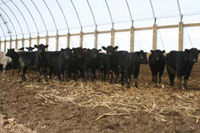The Million Dollar Advantage
How would you spend a million dollars? It is kind of a million dollar question. Would you put your kids through college? Take your family on a nice vacation to a place you have only dreamed of? Maybe even buy 100 acres of farm ground in Northwest Iowa. Why the question? What does it matter? Recently when walking a perspective customer through his options with Hoop Beef System, as compared to another way of feeding cattle under roof, the difference was over $1,000,000.00** in ten years!
Now, before you stop reading because you think this impossible, let me show you the money. This is basis a 500 head project of new construction in the upper Midwest. Names have been changed to protect the innocent.
Jim was considering a single sloped cattle feeding building (a building not a system there is a difference) for his operation. Jim is considering the same capacity of the Hoop Beef System. As a trusted advisor to his operation, we began the comparison with the basic equation: Cost of construction + Cost of daily operation=cost per head per day (yardage) over the amortization period. Jim had chosen a 10 year payoff period for his project. With the single sloped building he was considering, the per head of capacity cost was $250 per head more than the same capacity Hoop Beef System. The difference in up-front cost was $125,000.00 with interest at 5.75%; this was a $164,653.00 difference over ten years. Advantage Hoop Beef System. That’s just the additional cost of construction.
The other building was fully concreted throughout the floor plan. The best university research available today states that a single sloped building will require 11lbs of bedding per head of capacity per day. This correlates to 3.3, 1100 lb. corn stalk bales per head of capacity annually or in Jim’s case 1650 bales. At Grand Meadow Feeders, a Hoop Beef System feed yard, the annual bedding usage is less than one bale per head of capacity, but for the sake of argument let’s say 1. For a 500 head operation, that is 1100 bales difference annually. According to Rock Valley’s hay auction last fall that bale is worth on average $32.50 per bale. That is a $35,750.00 per year advantage to the Hoop Beef System. That is $35750 x 10 years = $357,500.00 advantage.
What goes in must come out. As there is no available university information on manure production, we will assume at minimum that you will have to haul at least the additional 2530 lbs. of bedding, used plus an additional 40% in moisture for a total increase of 1.77 tons per head or 885 tons per year, at an average spreading cost of $10 per ton that is $8850.00 per year. Note that the crop nutrients come from the cattle, not the bedding and adding additional volume to the manure dilutes the manure resource, which increases the tons required to get the same crop nutrients dispersed. For ten years, $8850 x 10 = $88,500.00; advantage Hoop Beef System.
The best advantage is the knowledge and cattle feeding and marketing experience that we bring to our customers. Our marketing agreement with those that purchase our cattle, over the past 6 months has added an average of $37.50 per head over what the average producer received for his cattle in the same period. Our ration design and its corresponding cattle performance saves on average $.1925 per head per day, in a 210 day feeding period that is $40.42 per head per turn. Follow the money, $37.50+$40.42=$77.92 per head. Assuming an occupancy rate of 90% on an annual basis gives us 1.64 head fed per space of capacity annually. 500 head capacity markets 820 head per year. 820 hd x $77.92=$63,894.00 x 10 years is $638,940.00. Advantage Hoop Beef System.
- Cost of Construction $164,653.00
- Cost of Operation $357,500.00
- Manure Hauling $88,500.00
- Hoop Beef System Premium $638,940.00
Total Hoop Beef System Advantage $1,249,593.00**
I believe you know what Jim decided was the best way to position his operation for the future. When you do the comparison, you see there is no comparison! This is why we are the leader in cattle feeding facility construction and management in the nation. Who will you hitch your wagon to? We inform… you decide.
We Got Ya Covered….Don’t track it in the house.
**No representation of profitability is hereby made. The statements and figures shown here are based performance and records from Grand Meadow Feeders. Neither Hoop Beef Systems, LLC nor it’s employees, agents or assigns make any warranty of any kind including the merchantability or results, relative to the information contained herein. Actual results will be affected by ability to gain, health of animals, management and previous treatment etc.

